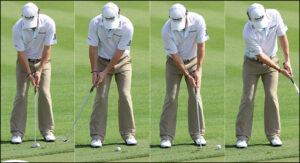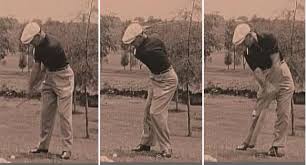Ever wonder why there are so many styles of putters? Even Odyssey, promoted as “The Number 1 Putter in Golf”, has more head styles than most other manufacturers. They may spend more on advertising and sell more putters but that does NOT mean that you are guaranteed to sink more putts with any of their putters. Try every type and weight of putter and focus on the one that gives you the most success and confidence.
Learn from the Pros to Improve Your Putting
Professional golfers who are winning tournaments are doing it with the fewest putts. If you want to figure out what works best, you should pay attention to what Jordon Speith and Rory McIlroy are doing. They may grip the putter in different ways but both use these principles of putting:
- Look directly at the ball as they swing back and through the ball. [For short straight putts Jordon looks directly at the hole as he swings straight to the hole.] Most golfers look up as they hit the ball so they miss watching the STRAIGHT swing of the club through impact with the ball.
- Pros impact their putter exactly in the center of the putter face. When you hit toward the toe or heal of the putter face it will throw your ball off the intended line.
- They swing directly up their putting line without arcing the putter as they pass the point of impact. Any motion off the target line will spin the ball sideways away from target line. Michael Breed pointed out that Jordon grips with his left hand low so that he can drag the putter with his leading arm directly up the target line. [NOTE: For 4 to 20 foot putts I found that releasing the grip with my trailing hand and finishing my swing by pointing the putter straight up the target line with my leading hand helps me avoids arcing the swing of the putter to avoid any side spin on the ball.]
- They swing by rocking their shoulders and eliminate any wrist action.
- They always attempt to hit past the hole (10 to 15 inches) to ensure that they:
a. Reach the hole [as 100% of short putts never go in the hole]
b. Minimize the impact of flaws in the green as the ball slows near the hole
c. Minimize the break as the break is greatest as the ball slows down.

Rory putts with his shoulders. He keeps his head focused on the ball at rest to help him swing STRAIGHT through the ball. He also sways his hips up his target line.
There are Exceptions to Every Rule:
Jack Nicklaus putted to die into the hole. If the speed of the green is very fast and the slope of the green is very sloped you can’t afford to hit well past the hole. You have no choice but to let the slope of the green allow your ball to “die into the hole” or to keep it close for your tap-in.
Green speeds change every day based on timing of the last roller compression, the growth & direction of growth of grass, sand or fertilizer application and moisture content. At the very least you need to understand the speed of the greens on the practice putting green before you start your round.
Practice and experience are the best ways to improve your putting skill. You need to develop a 6th sense to account for the feel of each putt. Rory and Jordon are both young so their skill is coming from their recent knowledge which developed their 6th sense. You can also use GOLFSTR+ to help you learn to putt by rocking your shoulders and by locking your leading wrist. Practice with it to improve your putting and 5 other swing problems! Buy one today at www.golfstr.com




![Let your trailing elbow fly like Jack Nicklaus and then swing up the inside slot to your target line. [My personal breakthrough]](https://golfstr.com/wp-content/uploads/2016/01/Jack-Nicklaus-with-flying-elbow.jpg)